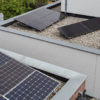Energy storage is in many ways the final frontier of the power landscape. While many energy generation technologies have become commercial successes, storage is still lagging behind. And, it’s a big deal.
Nowhere is the generation-storage divide more visible than solar energy, particularly in Australia. New solar power systems are being added to the national grid at a very rapid pace causing an energy surplus much of which goes to waste.
Since this trend will only accelerate moving forward, we need affordable, quality energy storage devices that can store all the surplus power. Unfortunately, these technologies aren’t quite here yet.
The new graphene aluminium ion batteries promise to solve these problems, provided they can be made commercially available.
Graphene – The 21st Century Wonder Material
Graphene has been the promised compound for quite a number of applications due to its unique properties for decades now. It is the thinnest compound known to us as its structure consists of a single layer of carbon atoms.
Its unusually regular arrangement makes it both extremely strong (200 times stronger than steel) and very conductive as electrons can easily move between atoms.
These properties make graphene an ideal candidate for a number of use cases, including stronger product shells, bullet-proof armor, wires, solar panels, sensors, and of course, batteries.
Graphene can enhance energy storage in a variety of ways. Its high conductivity enables faster charging and energy transfer without overheating. Since graphene is very flexible, it can be wrapped around a battery’s anode or cathode material allowing for an overall higher energy capacity.
While extremely useful, graphene is not readily available in nature and needs to be grown in a lab, which is a complex and expensive process. Currently, a kg of graphene costs between USD 50 to USD 200 depending on its purity.
So, How Does Aluminium Help?
While Lithium-Ion (Li-ion) batteries have served us well, they are beginning to show their age. Modern consumer electronics are becoming increasingly powerful, requiring higher energy densities, and faster charge/discharge rates which current Li-ion cells are struggling to keep up with.
The organic solvents used in Li-ion batteries are prone to catching fire, which is why we have so many stories of smartphones going boom inside pockets. This is also why Li-ion batteries with more than 160 watt-hours of power are prohibited in airplanes.
Finally, Li-ion cells use rare earth elements including lithium and cobalt, both of which are expensive and hard to procure. Cobalt for example is mostly found in Congo and has been mired in unethical mining controversies for a long time now.
Aluminium-ion batteries provide a very viable alternative to Li-ion. These batteries use an aluminium anode, a graphite cathode placed in an electrolytic solution. Even though Aluminium batteries have a lower voltage potential than Li-ion (2.65 volts vs 4 volts), they have much higher energy density (1060 Wh/kg vs 406 Wh/kg).
While recharging, each aluminium ion carries three electrons as against one electron in a lithium ion. This in theory allows aluminium ion batteries to have a transfer rate three times higher than Li-ion batteries. Their chemical properties also make them resistant to spontaneous heating and will never catch fire like Li-ion batteries do.
Graphene and Aluminium for the Win
So, aluminium clearly offers great advantages over Li-ion and is cheap to boot, so, why aren’t all cell phones packed with them by now? Even though the technology is promising, it has its own challenges.
Current aluminium-ion batteries have a far shorter shelf life than their Li-ion counterparts. Since aluminium ions are larger than lithium ions, they often fracture the anodes that leads to quicker degradation.
However, new technologies developed by Brisbane based Graphene Manufacturing Group (GMG) and University of Queensland’s Australian Institute of Bioengineering and Nanotechnology (AIBN) are working on a graphene aluminium ion battery that hopes to overcome many of these shortcomings.
AIBM and GMG found a way to insert aluminium atoms between the tiny spaces in graphene sheets to create a highly conductive solution. The battery itself consists of an aluminium anode, a graphene cathode in an aluminium-chloride electrolyte.
While not the only aluminium ion battery type in research, AIBM and GMG’s approach offers various advantages over competing technologies. It is relatively cheaper to produce, charges almost 60 times faster and lasts three times longer than Li-ion cells, have no overheating problems and can easily be fit inside existing cell housing.
GMB is currently focussing on coin cells but is planning to expand into pouch packs soon, too. If successful, Li-ion cells in current consumer electronics can be replaced with aluminium ion cells as easily as changing AA cells in a remote control.
What Does this Mean for Solar Energy?
The technology obviously offers exciting opportunities for solar and EV battery storage. Aluminium is one of the most common elements around which will make aluminium-ion cells much cheaper to produce.
Their higher energy density, fast charge and discharge rates also bode well for solar batteries as residents will be able to quickly load up their battery banks and store more power in the same space.
More importantly though, the higher discharge rate will enable controlled offloading of stored power into the grid. Since peak grid times can be reasonably predicted, batteries with more discharge capacity will be able to sell more power than their traditional Li-ion peers during opportunistic time periods.
Should You Wait for an Aluminium Ion Battery to Hit the Shelves?
Even though the graphene aluminium ion battery is an exciting development, it’s still in the research phase and the first products are yet to hit the market. In other words, they may take quite some time to make it to the market, if at all.
If you do feel that your solar power system can use a battery, then existing solutions will suffice. Even though batteries seem like a logical part of a solar power system, many times, they don’t actually make any sense given their extremely high cost.
We at bidmysolar™ have helped hundreds of consumers save thousands of dollars on their solar purchases and will be happy to do the same for you. Since batteries can double or even triple the cost of a solar power system, we can help you figure out whether you need them. Feel free to reach out to us or call us at 1300 004 600 for more information.





